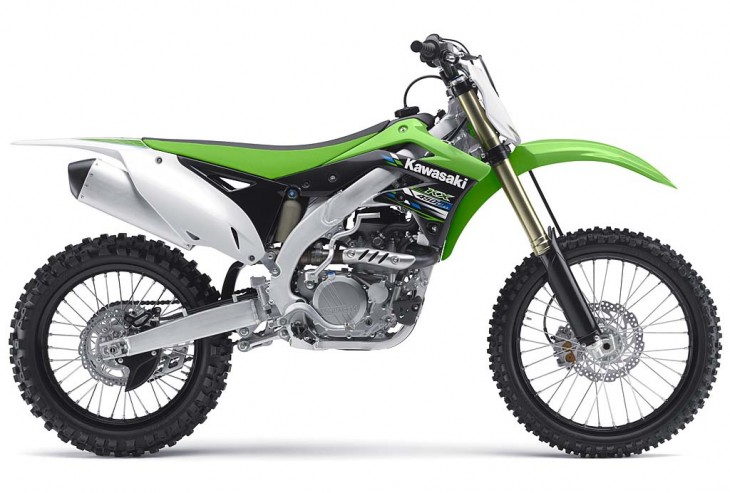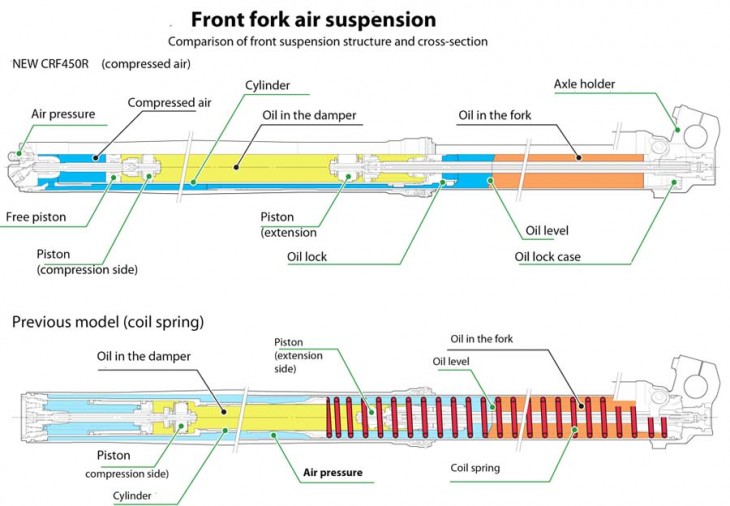Kawasaki and Honda have announced new 2013 model motocross machines, and the flagship of each brand, the Kawasaki KX 450F and the Honda CRF450R, each receive a new Kayaba, pneumatic front fork. The photo below is from Honda, and it illustrates the design of the new fork versus the prior Honda version. Notably missing is the heavy fork spring, and both Kawasaki and Honda claim the new fork is approximately 1.7 pounds lighter than the previous model. The new fork on each model is supposed to be easier to tune, and offer less friction for a smoother travel. This contributes to overall weight losses for both bikes for 2013.
Both the Honda and the Kawasaki 450s received engine changes, with the Honda getting an all new frame, as well. Revisions were made to the Kawasaki KX250F and the Honda CRF250R, as well, although they do not receive the air fork. Take a look at the Honda and Kawasaki websites for additional details and specifications.









Air forks have been tried on at least two production runs that I remember, the aforementioned YZ C series, and a mid 90s KTM four stroke. As another poster has already stated, I hope the engineers that designed these has solved the inherent problems associated with those designs.
having ridden air suspension on mountain bikes for years I’m looking forward to see how well this works.For a bigger guy air suspension sucks on mountain bikes.I am so sick of screwing around trying to get it to work well I’m looking for coil spring suspension to replace it with.All I know is for me at 240# $1000 air forks and a $500 shock don’t cut it.
My Y2K Honda XR 600R which is bristling with mid-eighties technology has air assisted forks somewhat similar to these. Air/spring forks are quite a bit different than air only and yes nitrogen is the preferred gas.
Those old Fox AirShox didn’t have springs. Air only. During the 1970’s.
Picture:
http://ltthor.home.comcast.net/~ltthor/rebuilding/FAS_vinatge_factory1.JPG
As you can read here, the main problem with these shocks was an increase in spring rate during a race due to heat build up:
http://www.foxracingshox.com/archive/downloads/history_of_fox_air_shox_2001.pdf
Kawasaki and Honda get New Air Forks but I think not reinvented their Fox Shocks.
“This contributes to overall weight losses for both bikes for 2013.”
I don’t know about the Kawasaki, but the Honda gained weight (according to Honda, the bikes are not out, of course).
I’m gonna have to get over my technophobia. I’ve had enough problems/frustrations just changing tubes mid ride, have some friends with mountain bikes going to the landfill because their air forks are obsolete and newer forks don’t interchange account steering stem diameter. Being as these are MX bikes they’re never far from the truck, airloss isn’t a big deal, on a mountain trail, bigger deal.
Those that ignore history are doomed to repeat it
2014: Air shock, and Brake Actuated Suspension System. 😀
In the mid 70’s I converted my Hodaka Super Rat to air forks. All you do is remove the springs and install a valve in the fork cap. It was the rage at the time. But we found the added air pressure made the fork seals drag (increased “stiction”). The fork was pretty rigid on small bumps, and springs simply worked better.
But my mountain bike (bicycle) uses air springs on the Rock Shox fork, and it doesn’t have this issue. I guess we will have to wait and see how well it works.
Re: mountain bike… yeah, my mountain bike had/has an air shock since ’95 and I put on an air fork in 2000. Funny how mountain bikes have gotten some things sooner than the moto industry.
Most recently, the BMW HP2 had an air shock. Haven’t seen anything about a moto air shock since, until now.
Fox made air rear shocks that were the hot setup on YZ80’s back in the late 70’s/early 80’s. They dominate the MTB suspension component market today.
Has Kayaba just reinvented Fox Shox?
Weren’t air shocks abandoned by most everyone because of the expansion of the compressed air when it heats up (using nitrogen helps some), thus changing the spring rate while you are riding? Also, aren’t pneumatic shocks incredibly hard to dial in to the perfect setting?
Heat expansion in the forks is not really an issue. The shock gets pretty warm, but not the forks. The big thing is the doubling of the air pressure with every one-half of the available fork travel you use. On current spring forks, the bleed valve is more for reducing built up pressure from cavitation.
If I recall my college physics correctly, you can’t avoid the generation of quite a bit of heat if you compress air quite a bit, and especially if you do it repeatedly over a short period of time (as in suspension).
Heated air expands. Hot expanded air won’t have the same “spring” rate as cool air.
These new forks may have a blow-off valve, but that would mean that air pressure would then be incorrect when the forks cool.
I’d love to hear from the engineers who created this fork to see what they learned from past examples of pneumatic shocks and what they have done to avoid the pitfalls encountered in past examples.
For every compression in the fork there is an equal expansion (rebound)… So its +-0 in that regard. Its the damping that converts kinetic energy to heat and warms the suspension devices. As far as the expansion of air when heated; its mostly due to the moisture in the air. Dry air (mostly nitrogen) doesn’t expand significantly.
The cross-section drawing looks like a 1976 advert for a YZ250C!
I wondered if anyone was gonna remember that Yamaha had no coil springs in their forks decades ago. They had a large plenum chamber atop each leg. The went back to coil springs in subsequent years.
Yeah, and it seems like the design was not all that different except that the floating piston was up inside the speedometer/tachometer……LOL!
27 years ago, I had air forks on my GPZ900R.
I guess we’ve come full circle again..
With no fork springs?